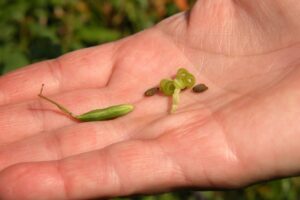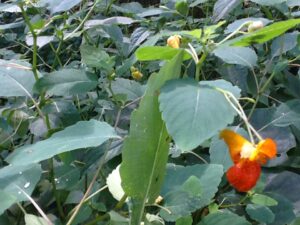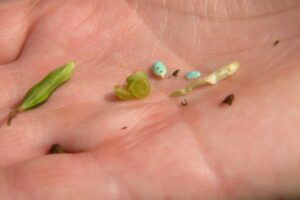By Wren Smith
The natural world is full of hidden jewels, and late summer is a great time to seek out some specific ones along the Bent Twig Trail. Today, let’s explore patches of jewelweed, Impatiens capensis that skirt the wetter portions of this trail. At Bernheim, I often find jewelweed growing at the edge of the woods near streams or ditches. Jewelweed plants aren’t exactly hidden, as they often grow 3 feet high or more, and announce their presence with bright orange trumpet-like blossoms that have burnt orange spots inside each bloom.
For me, it’s not the plants themselves that are the hidden jewels, but a secret turquoise treasure hidden in the heart of each jewelweed seed. I’ll explain shortly.
As the genus name, Impatiens indicates, jewelweed is closely related to our garden impatiens. This genus name makes sense, as the plants seem impatient to send their seeds flying out away from the parent plant where the seeds have a better chance of growing into mature plants. This wild relative, commonly referred to as spotted touch-me-not, also disperses its seeds though an “explosive” coiling, actually uncoiling, mechanism. When its elongated and swollen seedpods are gently squeezed, the pods pop open and send their seeds flying. I’m easily entertained, and thus enjoy helping jewelweed expel their potential progeny to more suitable growing sites. I simply give the swollen seedpods a slight pinch and enjoy the results. It is more addictive than popping bubble-wrap. Try it yourself, and you’ll see what I mean.
 An annual native wildflower, jewelweed stems appear somewhat succulent or translucent with thicker and darker colored nodes.The juice in these stems can be used to help remove the rash causing oil (urushiol) in poison ivy, thus it is often cited as a poison ivy deterrent. The leaves of jewelweed are somewhat oval, blue green above with gently scalloped margins. The underside of the leaves are pale green and look like quick silver if submerged under water.
An annual native wildflower, jewelweed stems appear somewhat succulent or translucent with thicker and darker colored nodes.The juice in these stems can be used to help remove the rash causing oil (urushiol) in poison ivy, thus it is often cited as a poison ivy deterrent. The leaves of jewelweed are somewhat oval, blue green above with gently scalloped margins. The underside of the leaves are pale green and look like quick silver if submerged under water.

Some authorities say this is why it’s called jewelweed; others report that the name refers to how the flowers hang like little jewels. However, I have my own interpretation for the appropriateness of the common name, jewelweed.
To uncover the hidden jewel in spotted jewelweed, simply pop open a ripe (swollen) seedpod in your closed hand, so that the seeds don’t get away from you. Take one of the seeds and gently scrap away the outer covering with your finger nail, being careful not to crush it. This turquoise jewel has been hiding in its pickle-shaped pod, perhaps waiting for someone to uncover its lovely hidden heart. In the natural world there are many treasures waiting to be seen, experienced, valued and shared; in doing so, our own hearts may be revealed.
Want more Tales from Bent Twig? Click here to view the archive.




